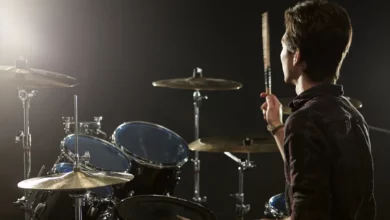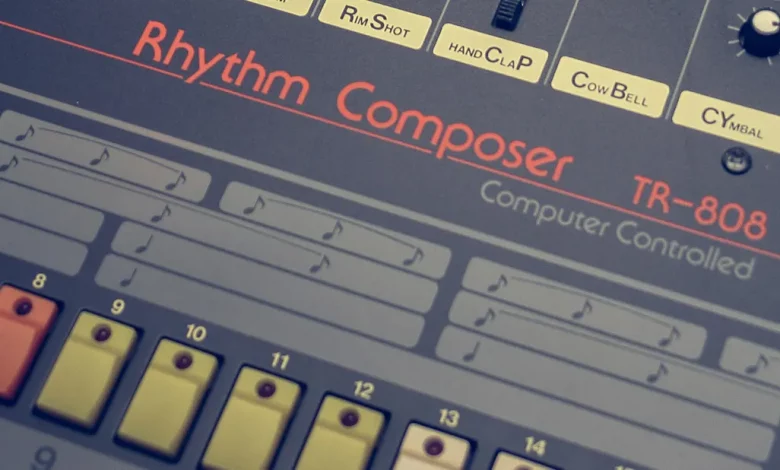
We may earn a commission from the affiliate links on this site. Learn more›
Years ago the word drum machine conjured up rhythm makers that robotically played along with massive electric organs. However now thanks to a few major revivals in the 1980s and 2010s they have become competition for live drummers! However, even drummers are finding that these devices can help with learning and recording and today we will look at some basic programming of electronic drum machines.
Drum Machine Apps, Software, and Hardware
There are so many drum machines to choose from, you can buy and play an actual instrument or even an app on your phone. The analog machines are nicer for hands-on experiences, but you can accomplish just as much with software and it is a lot cheaper. In fact many apps and software drum machines offer free trials so it is best to try a few different kinds out.
If you have an electronic drum set you may already be setup with a built-in drum machine in the e-drum brain. Drum machines are not just made with electronic sounds, they are now analog recordings that are chopped up into samples. Swing and syncopation are difficult on a sequencer, but thanks to live sampling we can now play styles like reggae and Latin with drum apps.
Most drummers and home producers use drum machines for these reasons.
- As a practice aide while playing, they help guide your patterns
- On their own they allow you to easily play new genres and styles
- They can be added to the overall recording to thicken the drum sound
- Drum machines are simply fun to play and lead to new songs and ideas
Drum Machine Basics
Just like any new instrument you must know the basics of what you are playing so be sure to read the instructions for the drum machine. Otherwise there are some universal terms you will come across.
Sequencer/Steps
The steps are where you program when a note is supposed to play, many sequencers have 8, 16, 32, or more steps so you can program multiple measures at once. The machine will quantize these notes based on how you program or play them. Of course how you break down that pattern is up to you; 16 steps can be broken down as 1/8 or 1/16 notes depending on your musical goal.
Some drum machines even allow you to adjust the steps to 6, 12, or any other number so you can do different time signatures. It can take a little math at times to calculate just how many steps a unique song may need, but it is excellent practice. Start with 4/4 time as a beginner but be sure to branch out into more creative meters.
Sounds and Parts of the Drum
Most drummers are familiar with terms like kick, snare, open, closed, low, high, ride, crash, and other percussion terms. These are usually selectable by option or along the grid. Higher end drum apps have more drum parts to choose from. An analog drum machine will have specific sounds that can be manipulated, while a digital will have many different MIDI samples to choose from. The digital is often the best as you can even choose from different sampled acoustic kits!
Accents, Attack, Delays, Oh My!
Just like live drums we need to manipulate the notes played so they sound pleasant or real. We need the strike of the snare and decay of that sound to fit our tune, or the crash of a cymbal needs the right extension. Drum machines will have knobs or buttons that allow us to fine tune how we play our notes, a heavy accent on the 2 and 4 are essential for R&B and rock genres!
Swing and Syncopation
In real drumming swing is simply playing off time, at just the right time! It’s hard to learn in live drumming and it’s hard using computer rhythms too! Some drum machines use time delayed effects to mimic swing while others are a little better at shifting the underlying beat. Either way it is important to know how to use your drum app or instrument to create syncopation, it helps the final sound and ability to jam along with.
Even though it is important to read the instructions and watch videos, the most important part of a drum machine is to start playing. Try the presets out and pay attention to their patterns and sound adjustments for each drum part. After the presets start experimenting with the instrument and have fun, sometimes the best way to begin is by making small changes to the presets until you have something unique!
Popular Drum Machine Patterns
Another cool thing about drum machine exploration is that it can force you to investigate sheet music, after all it is the best way to verify if you have a beat right. Break the steps up correctly and program the notes that you see using drum notation. The hardest parts will be adjusting accents and swing to feel more human.
An easy pattern to start with is the basic 1/8 note Rock’n’roll backbeat on the 2 and 4.
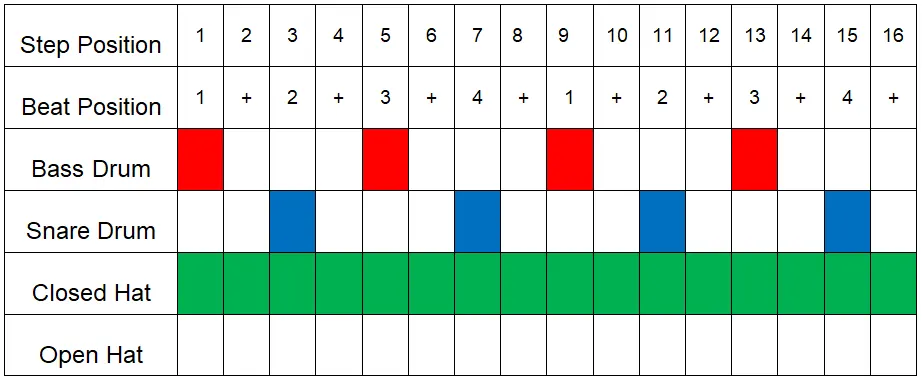
Now imagine if you were playing the drums you would want to add some variation in and this is best done by opening the hi-hat.
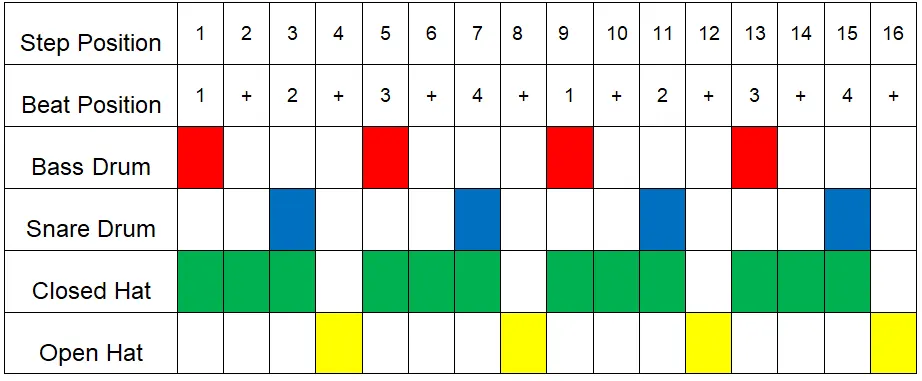
Now from here you can start adding in more bass and snare hits, and even break the hi-hats up a little bit. If we want a groovy or danceable beat then we must add a lot of tension and release to help syncopation. Also make sure as you try these grooves out to adjust the tempo!
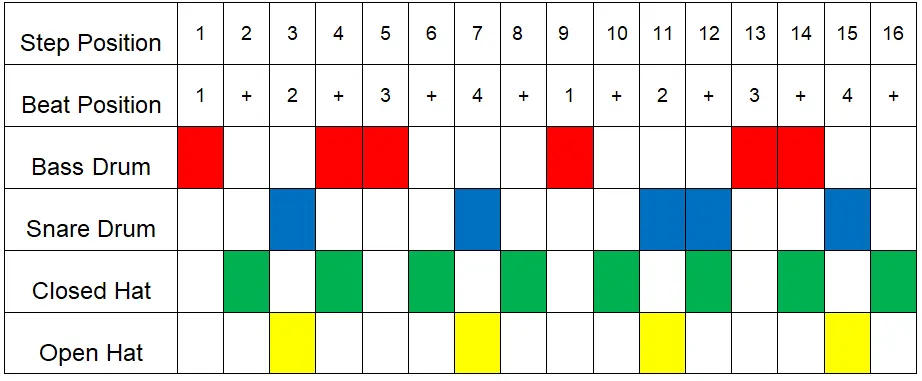
Sometimes leaving a rest at just the right moment can help break the beat up. If your drum machine has a lot of steps it will be easier to program slight differences in the measures so that the rhythm is not so rigid. However some genres prefer a strict repetitive beat like Hip Hop and EDM.
A more Rockabilly or country groove will have this underlying structure. You may need to put a little swing or delay on the snare to get a better vibe. It also helps to add a rim shot, wood block, or even cowbell in. Just keep the hits simple like the tunes of the 1950s and 1960s.

If you have trouble getting a realistic train type beat, it will require you to accent some of the snare hits. Or if you add a slight delay to just the snare part it will create more of a drum roll sound. The technology exists to sound like a real drummer, you just need to tweak the right buttons!
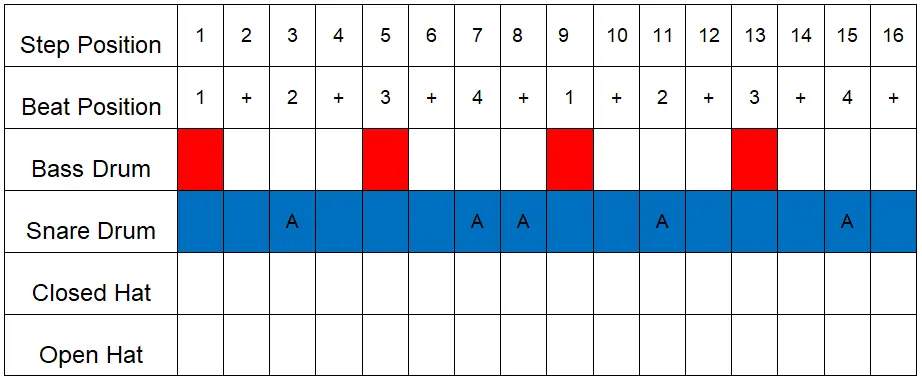
Most of these patterns can be used across a variety of genres, here we have a common upbeat gospel pattern that looks very similar to the rock and R&B above.
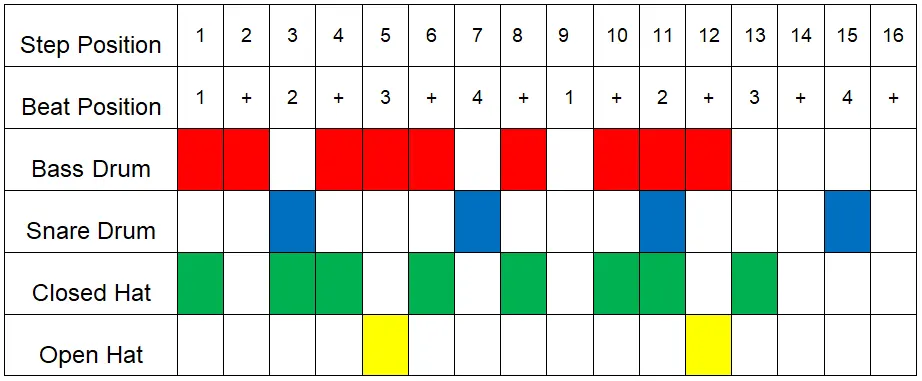
If we cut back on some of the notes we can get a Motown groove.
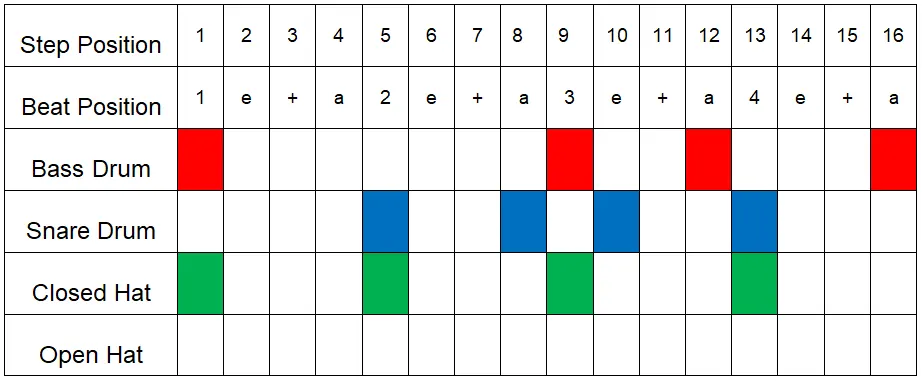
Now for a genre like reggae we must focus more on the hit on the 3rd and fine tune the delay so we can get close to the proper syncopation.

This is as basic a rhythm as you can in reggae, if your drum machine does not have a rim shot you may have to try a snare on that 3rd downbeat. As you get these very simple structures down you can start adding in more parts like your toms.

And of course you can add in more parts to your other beats too. Keep it simple and build based upon what sounds good.
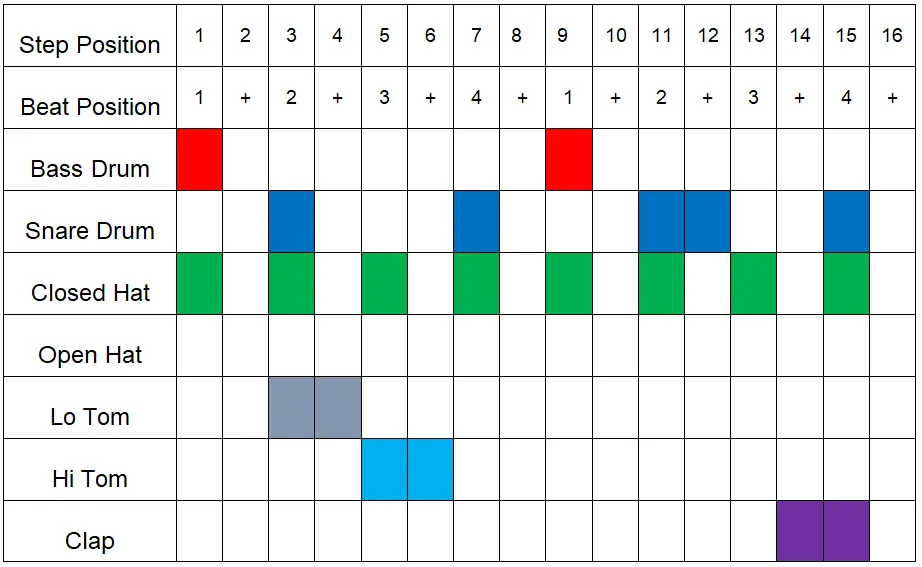
Notice when you play these patterns slowly and with delay they sound funky, when you speed them up they turn into fast rock or dance. In fact if you fill every bass drum step and add just the right amount of delay you can approximate heavy metal double pedal speed.
Here are some more popular rhythms that have been sampled repeatedly throughout music history.
Funky Drummer
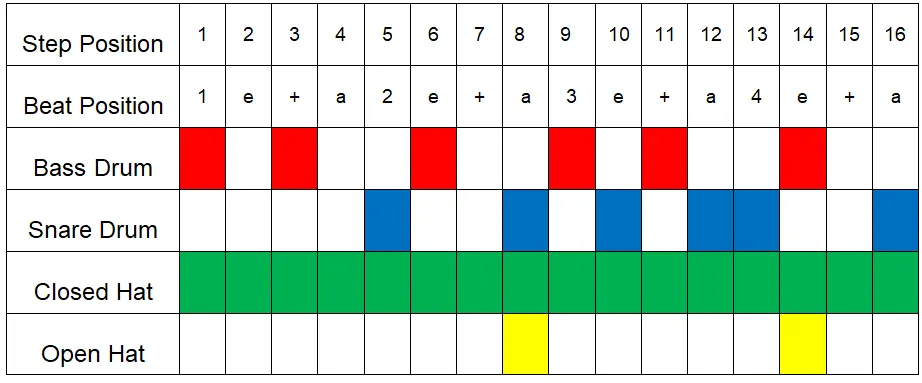
Amen Break
First two bars

3rd bar
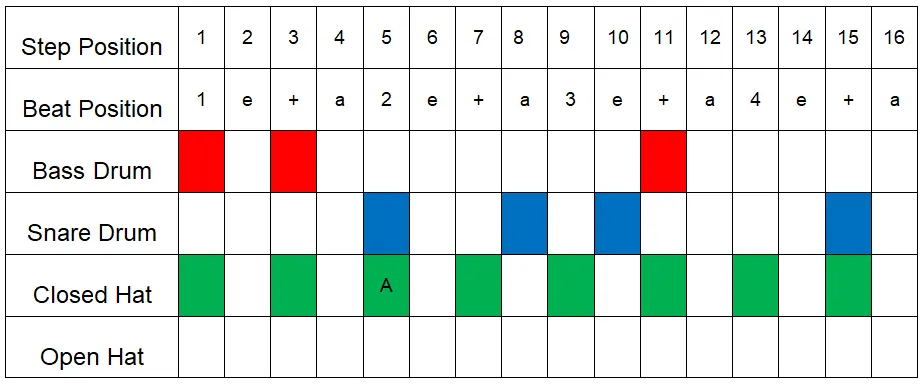
4th Bar
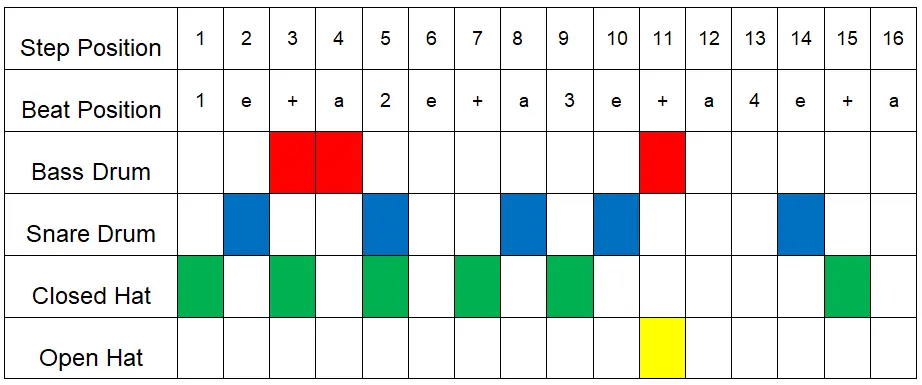
Impeach the President
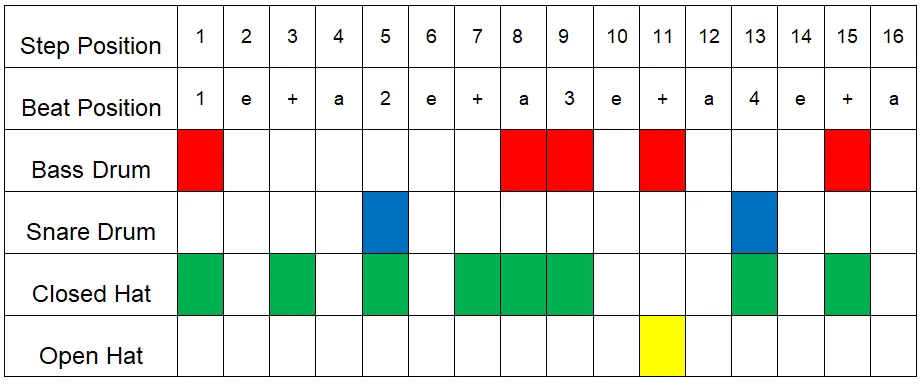
Walk This Way

You will find some popular hits do not translate perfectly onto drum machines because of the occasional human playing factors.
When this happens you must try your best to find a work around in the drum machine. And here are two more patterns that are not 16 steps based, that way you get an idea on how to use different time signatures.
12 steps can be divided as 12/8 or 6/8, here is a basic 12/8 pattern.
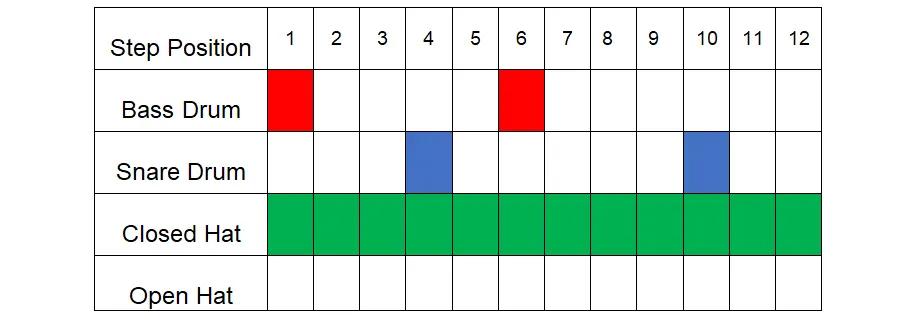
A 6/8 pattern
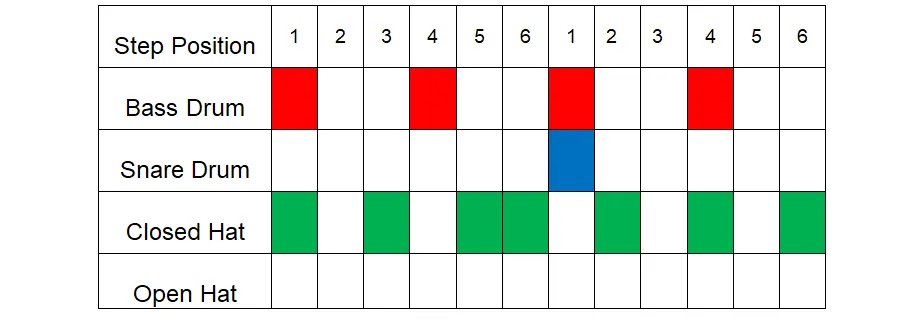
Of course there are many more patterns out there and it is fun to take different sheet music and reverse engineer the sequence.
That is one of the main reasons playing drum machines can even help with regular drumming, you start to see the whole picture and all the genre similarities.
Go download any drum app or get an actual drum machine and you will see how fast your percussion knowledge will grow.


